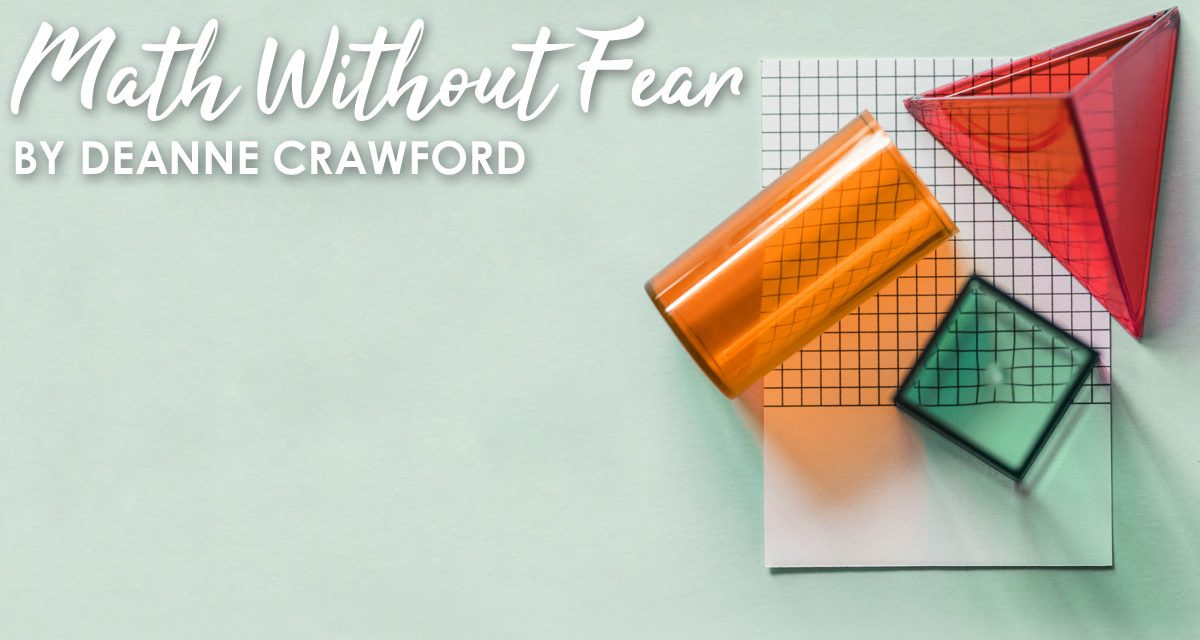If you have 4 pencils and I have 7 apples, how many pancakes will fit on the roof?
Does this math problem, popular on the internet, represent your feelings about teaching math? I know it does mine! I have heard it said that math is second only to public speaking in producing anxiety in children and adults. Interestingly, the academic study of math anxiety began in the 1950s with the purpose of solving the dilemma. One thing research has shown is that math anxiety is not only a real issue, but it is also a shared experience, common to teachers, parents and children.
In our family, one of our children experienced significant math anxiety. Many tips and tricks were tried: some we found helpful, others not so much. My hope today is to provide you with a variety of ideas allowing you to find the best fit for your family.
As the teaching parent, our attitude toward math influences our children more than we may realize. Love or hate it, as teachers we want to encourage our children to appreciate math, while at the same time not forcing them to love it, just because we do! If you struggle with math, check out the helpful resources from You-Cubed. Developed by a Stanford University Math Professor, this website offers resources to support parents and students in math. Playing math games, understanding number sense, and encouraging our children are just a couple of the six easy-to-follow-suggestions in her Advice for Parents tip sheet.
What if our children are the ones struggling with math anxiety? There are many reasons for this, especially if we are teaching a child who had a negative experience in a school setting. Here are a few ideas to promote a positive math experience.
- Younger children (PreK-3rd grade) are at the beginning of the math journey. This is the perfect time to develop a positive attitude for math. As a parent, encourage your child. True, there is only one right answer to the math problem, but if the child gets the wrong answer, stress that everyone makes mistakes. Ask them to share the steps they used to solve the problem. As they share, ask them gentle questions about the process. Make this a time of encouragement and problem solving. Teaching to our child’s learning style is also vital. While important at all ages, it is vital in the elementary years. Let’s take a quick look at learning styles and related teaching tips:
- Visual Learners are the children best summed up by “seeing is believing.” They are distracted by new sights but will remember where they put things. Children who are more visual respond better to pictures or visual associations, diagrams, displays, demonstrations, handouts, and videos. Allowing them to draw a picture that represents the math problem is helpful. White boards (or chalk boards) are an excellent tool for visual learners.
- Auditory Learners remember information by hearing or talking. You may notice this child often reads aloud to themselves. Following oral instruction well, he may quickly do the problem in his head but have trouble writing it on paper. Music, rhymes, and the opportunity to do math orally are key for this type of learner.
- Kinesthetic/Tactile Learners are your movers and shakers. You may notice this child has trouble sitting still or is always touching things. Kinesthetic children need to be involved in their learning – moving, touching, feeling, building, writing, or doodling. Reinforce math facts by playing math hopscotch or practice math facts while throwing a ball. Math games like Math War are also a terrific tool.
With our younger ones, it is helpful to keep in mind that math concepts move from concrete to abstract. What this means is that some children may need more visual instruction or tactile instruction to understand the concepts. Let them feel it, touch it and build it. Teaching with math manipulatives, LEGO® bricks, or through games is instrumental for future math success.
When children reach the middle years (4th-8th grade), attitude toward math is vital. Encourage, encourage, encourage! If frustration or anxiety rears, take frustration breaks! It is OK to go outside and dribble a ball or run around the house to release emotions. Some families find playing soft music in the background helpful. Continue to accommodate their learning style, even if the curriculum no longer incorporates concrete teaching.
At this age, understanding the relevance of math is also key. Find ways to create real-life story problems. Take a family favorite recipe and double it. Take the same recipe and cut it in half (or thirds). Give your child a grocery budget and go shopping. Garage sales and lemonade stands provide great opportunities for math practice. Calculate trip miles and gas consumption. If you are short on ideas, check out these real life math resources: Grocery Cart Math, Math for the Real World and Edward Zaccaro’s Problem Solving Books.
At the high school level, the above suggestions may still be helpful. At this stage, anxiety may look more like a mental block during math lessons. Relaxation techniques, fidget toys, and frustration breaks may all provide a level of support. Some families find it helpful to include nontraditional resources for teaching in a non-stress manner, such as Barron’s EZ Math, Learn Math Fast or Life of Fred. Other families find it helpful to connect with a local tutor. One of my children did well with math until taking the ACT. Mental blocks, frustration and tears followed. We also connected with a local high school math teacher, who provided the needed support, review and encouragement to overcome her fear of testing.
Finding the best way to teach math to your children may be trial and error, but the results are worth the time and effort. I pray these suggestions were encouraging and helpful to you. Have math questions? Reach out to us at consultants@rainbowresource.com. We are happy to help! ~ Deanne





